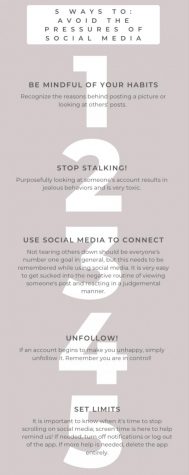The Pressures of Social Media
April 12, 2021

Peer pressure is a difficult influence to steer clear of as an adolescent, however, younger generations have been presented with a new type of pressure: the pressure of social media. Some teens feel pressured to always be available while others feel pressured to impress. Regardless, teens all over the world are experiencing the same unhealthy social media habits, resulting in an extreme disconnect with reality.
Both iMessage and Snapchat have been detrimental to the amount of time teenagers spend away from their phones, and the new features of social media platforms are no help at all. Features like the Snap Map and Instagram’s “last seen” increases the need to be available. Individuals who view these features could potentially feel ignored and insecure when they notice someone is active on social media yet not responding to their texts or snapchats. Checking snap scores has become a popular way of checking whether or not someone is active on snapchat, but ignoring someone’s snap in particular. Because of these features, teenagers evidently struggle with the constant pressure to be available on social media in order to feel as though they are not deteriorating their relationships.
If you haven’t heard or experienced FOMO, you have finally been introduced to it. FOMO is the acronym for a fear of missing out. You can find teens who experience FOMO typically checking up on what others are doing by purposefully viewing Snapchat/Instagram stories, or checking where there are by purposefully viewing their snapchat map. Social media has become a dangerous place for those who have a severe insecurity with what themselves are doing. According to Trust Pulse, 45% of people who experience FOMO can’t go for longer than 12 hours without checking social media.
For girls in particular, Instagram has become an extremely harmful platform. Teenage girls usually feel an immense amount of pressure to live up to the societal standard of looking pretty or having a good time as a member of the younger generation, however this presents more negative emotions than positive. A goal of most teenage girl’s is to upload pictures that present a perfect image in order to receive positive feedback through comments, likes, views, or even shares. No matter what form, most teenage girls expect positive reactions, affirmation, and compliments, but it continues to normalize an unrealistic image that does not exist. It is much healthier to post a picture because one feels confident and happy with the photo, not because of a goal of validation through likes and comments and reposts. According to Trust Pulse, 40% of people say they spend money on something once per year to post it on social media. Taking this into consideration, it is clear that many individuals are motivated to attend certain events or accomplish certain goals by posting on social media in order to be seen by others
Deleting these apps is surely a way to reconnect with reality, however, teens feel pressured to stay on social media in order to stay in touch with friends. The circumstances presented by the pandemic have been a big factor in this decision considering many teenagers aren’t seeing the people they would typically see on a daily basis in school. The fact that some friends have a preference of communicating through snapchat, makes this worse for the teens wanting to check back in with reality, almost forcing them to stay on social media in order to stay connected and in the loop.
Recently, a junior from East, Sophie Angulo (‘22), has disabled Instagram and deleted Snapchat.
Angulo believes “ both [apps are] great platforms for communication, but they sometimes interfere with [her] concentration on school”.
She claims to have a “love/hate relationship” with Instagram.
“I love taking pictures and sharing them with friends, but I find it really hard to not care about the amount of likes and other types of reactions I get,” she says.
Angulo also touched upon the fact that instagram does not present the amount of hours she spends on school work or the long shifts she works after school.
“It only displays the good parts of my life which can be so misleading”.
Angulo proves that it is very possible for teens to step away from the screen and take a break from social media, however the larger steps she took like deleting the platforms can be difficult for those who have become so attached. Several good alternatives would be setting time limits on the apps as well as logging out for periods of time to ensure the amount of time away from social media.